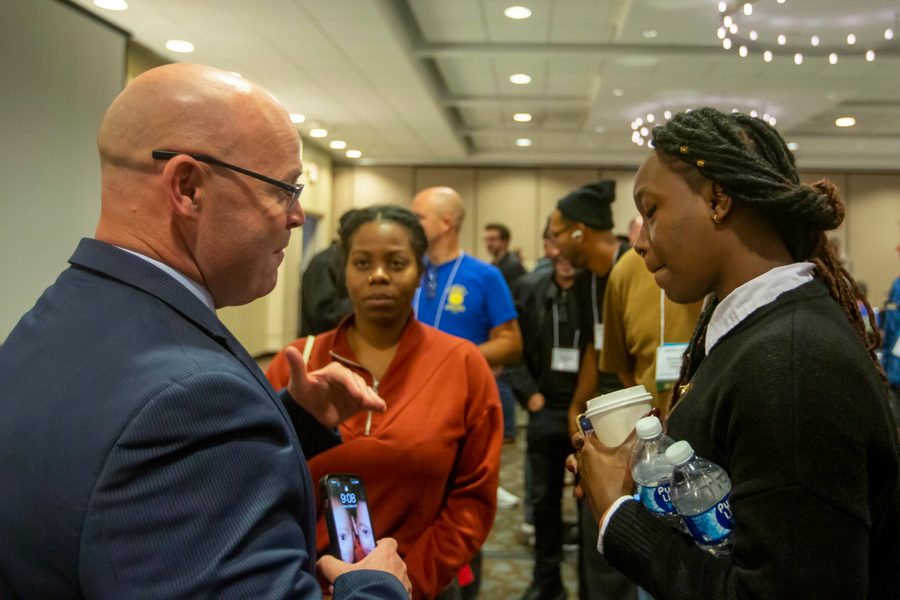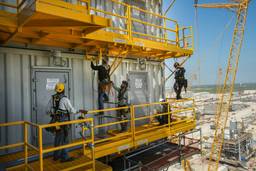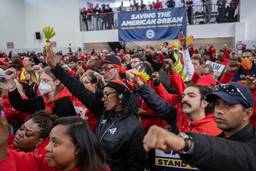Teamsters President Sean O’Brien Vows to “Pulverize” UPS in Fiery TDU Convention Speech
The first TDU-endorsed leader in 30 years sought to meet the hopes of the militant rank-and-file, promising a UPS strike if needed.
Stephen Franklin

CHICAGO — Spelling out union strategy for an all-important contract with UPS, Sean O’Brien worked his way up to a fiery pitch. “We gotta strategize, we gotta organize, and then we gotta pulverize UPS,” he declared.
The room erupted into cheers, applause and fists clenched upward.
The presentation by the short, muscular, bald-headed, fourth-generation Teamster from Boston, a union member since his teenage years, felt like a shop steward’s typical nitty-gritty warm-up speech.
Listening near the back of the conference, Dan Campbell, 69, a retired Teamster from Wisconsin, felt lifted by what he heard. He liked O’Brien’s “hard-nosed” tone and especially liked his call “for everyone to get on board and row with all hands.”
O’Brien is president of the one-million-plus Teamsters Union. His energized appearance here, at the 47th annual conference of the Teamsters for a Democratic Union (TDU) at the end of October, says a lot about the embrace between the new Teamsters president and the TDU, a long-time dissident movement within the union.
O’Brien’s words echoed TDU’s perennial call for tougher bargaining, better benefits, union transparency and a voice for rank-and-file members in how the Teamsters operate. The last time TDU endorsed the union’s national leader was in 1991, with the election of Ron Carey. But Carey was forced out of office in 1997 because of election wrongdoing by campaign aides, which led to the 23-year reign of James P. Hoffa, an arch foe of TDU and son of the union icon James R. Hoffa. With little money and staff, TDU became the conscience of the Teamsters. It called out corruption and mob ties and annually tallied union leaders’ hefty paychecks, pointing out often that Hoffa was the nation’s highest-paid union leader.
O’Brien’s speech was also chance to dispel any lingering doubts about his loyalties.
A union vice president under Hoffa and head of Local 25 in Boston, O’Brien had once been briefly suspended for harassing TDU members. But O’Brien fell out of favor with Hoffa in 2017. In 2021, he formed a competing election slate with Fred Zuckerman, a Louisville Teamster leader and TDU ally.
With endorsement from TDU, the O’Brien-Zuckerman slate handily beat the team promoted by Hoffa, who was retiring. But only 15% of eligible Teamsters voted, a reminder of a longstanding problem. It was the lowest figure in recent years amid a steady drop in Teamster election turnouts.
The union’s challenges are many.
Its membership has slipped from 1.4 million in 2000 to just over 1 million in 2021, although union officials say that number climbs to 1.2 million when counting workers who opt out of membership but pay fees for the union’s representation.
There’s also discontent among UPS members who voted down the most recent UPS contract in 2018, only to see it overridden by union leadership. That was a gripe aired by UPS workers, who were well-represented at the gathering.
The contract with UPS, which expires in July 2023, matters greatly for the union — because the Teamsters represent 350,000 UPS workers, a huge chunk of the union’s total membership. It matters even more for a nation bound to a colossal time-driven supply chain. A 15-day strike by 185,000 Teamsters in 1997 quickly led to a favorable deal for the union — largely because the shutdown brought UPS to a halt.
Saying he is not afraid to fight UPS, O’Brien explained at the TDU meeting that the union has a $350 million strike fund and a grassroots contract campaign strategy. A top contract goal is eliminating lower second-tier wages, introduced in the most recent UPS contract, he says. He adds that the union will strike if UPS does not comply, and vows to seek higher wages and a path to full-time jobs for the part-timers who, reportedly, account for two-thirds of UPS workers.
Affirming his commitment to the rank and file, O’Brien says the Teamsters would first negotiate with UPS for local agreements and then work on a national deal, reversing the union’s previous bargaining pattern.
Beyond its showdown with UPS, O’Brien tells In These Times that the union has set up a division with a focus on Amazon workers (though he was short on tactical details, saying the Teamsters will create widespread pressure nationwide for Amazon to open its doors to the union, but will not “go through the NLRB process now” to petition for union recognition).
Expanding its warehouse worker members could be an enormous boon for the Teamsters, which has failed to ride the boom in the warehouse sector that has hit over 1.7 million jobs, more than double the number in 2012. Overall, warehouse work has steadily slipped from organized labor’s grasp. Unions represented 28.1% of all warehouse jobs in 1983, but by 2018 it had declined to 6.7%.
For TDU — one of the longest running reform movements in U.S. labor — the annual gathering (of just under 500 supporters, about a third newcomers) was a celebration of sorts.
It was the largest turnout in 25 years, Dan Campbell said with a smile. The Wisconsin Teamster helped out at the gathering’s registration desk this year; he began attending TDU confabs in the 1970s.
It was not all good news, however.
There were downbeat accounts of the continued troubles TDU supporters have faced at locals where they are on the outs. UPS workers complained about lack of pay and difficult working conditions. Many female UPS workers talked about the lack of bathrooms and private facilities for them.
Teamster railroad workers, who account for about two-thirds of the nation’s total railroad union members, talked about the lack of paid sick leave, a major gripe with regards to the tentative contract with the railroads. After one session, a handful of railroad workers gathered around Matt Mortensen, of Local 2403 of the Brotherhood of Maintenance of Way Employees Division, to lament the crises they have faced when they do not have enough sick days.
But there was a sense of achievement felt by TDU members who noted the presence of local presidents elected on the O’Brien slate. A rousing cheer went up after Dustin Roach, president-elect of the 14,000-member Local 135 in Indianapolis, recounted his recent victory over incumbents he described as non-transparent. “We had a lot of contract negotiations without the members knowing about them,” he said. “Sean and Fred inspired us to [challenge the leadership].”
In the back of the room, where O’Brien had led a long and detailed workshop on the union’s strategy for dealing with UPS, Edward Jones, 37, a UPS worker and member of Local 2785 in the San Francisco area, paused for a minute to weigh the message he had just heard.
“It lets me know he’s in the fight,” Jones said. Then, with a sense of caution: “Let’s see how he follows up.”
A former labor writer for the Chicago Tribune, Stephen Franklin is a Pulitzer Prize finalist and an adjunct professor at the University of Illinois Urbana-Champaign School of Labor and Employment Relations.







